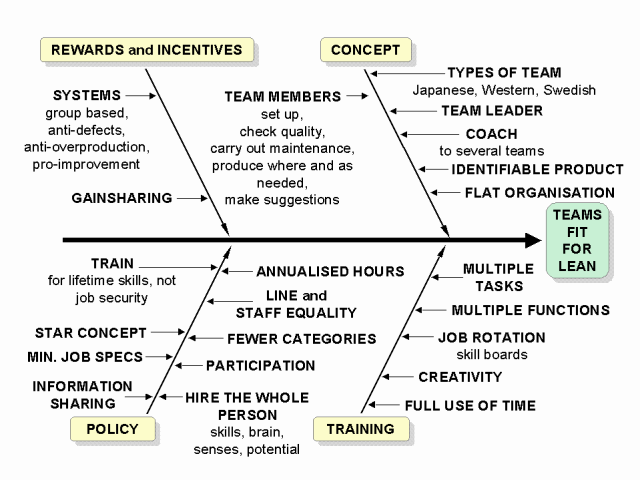
Lean and TEAM PREPARATION

Some Lean progress can be made without involving teams, but it will soon plateau. Lean is a team process. It requires new attitudes and practices by managers and operators. Trust on both sides has to be built over time. The aim is to create thinking, participating stakeholders, not mere employees.
A basic concept is to hire the whole person - his or her skills, brain, all the senses and all the potential. Aim to hire people who are willing to contribute in this full way. Most will need to be team players. Participation has to become the norm - progress displays, newsletters, and team briefings all help. Line and staff equality, on benefits, facilities, conditions of employment, and even parking fosters teamwork and communication, creates job security and drives out fear. Participation cannot include people improving themselves out of a job, but no company can guarantee ultimate job security. Everyone must understand the difference between the risks of the market and the security of making improvements. Training for lifetime skills is the ultimate job security for today's insecure market-place. A company may not be able to guarantee job security, but it can help operators to build their marketability and so benefit both company and themselves. Annualised hours helps with non-stable demand by calling in work as needed, but guaranteeing minimum and maximum monthly and annual working hours. This is a win for both company and operator. Fewer job categories leads to greater flexibility and improved security. The right attitude is more important than the right skills, many of which can be added later.
Capacity through people is the belief that capacity can be increased not only by extra machines and space, but also through people having greater and more flexible skills. Developing people is often more cost effective than buying physical plant.
Rewards and incentives must not compromise quality, nor encourage overproduction or any other wastes, but should encourage improvement. Gainsharing, with benefits shared on the basis of improvements, seems to be compatible with Lean. But the big one is recognition - always thanks, sometimes celebrations and recognition boards.
Incentive schemes need to reward the quantity of suggestions, not just the quality. The Pareto principle applies - a few good suggestions make a whole incentive scheme worthwhile, but to get just those few, many need to be sifted through.
The team concept is one of the most important developments accompanying Lean. It begins with operators that are multi-functional. This leads to quality of worklife - involvement, participation, security, growth, and even perhaps fun.
Edward Lawler's Star concept (People, Strategy, Structure, Processes, Rewards) is a useful checklist on areas that must be considered when setting up a team.
Teams evolve into self-direction, where team leaders are elected by, and responsible to, the team and not the company. At the same time, former supervisors become coaches who decide with, rather than for, teams. (Coaches are chosen by, and responsible to, management.)
Note that there are three approaches to teams. The Japanese approach uses teams for improvement and the team may have direct responsibility for line balance, but the supervisor has authority for work allocation and team well-being. Here there may be quality circles - voluntary but permanent. Toyota also uses several other types of team, which are appointed for a specific purpose and disbanded at the end of the study. The Western approach goes further with self-direction. Here the team eventually assumes responsibility for many activities - with team leadership rotating depending upon the problem. The third approach is the 'Swedish' model where teams build whole products or assemblies with very long cycle times. This approach has been abandoned by its originator, Volvo, but remains useful for some specialised tasks.
Skills should be displayed on a team matrix board using a U or other symbol that is filled in as team members progress from beginner to teacher. Training should include not only job skills, but also problem solving and teamworking skills.
Education and training should take place 'just in time' linking theory with immediate practice. There is a cycle to identify the next skill, train for it, test, and consolidate before moving on to the next skill.